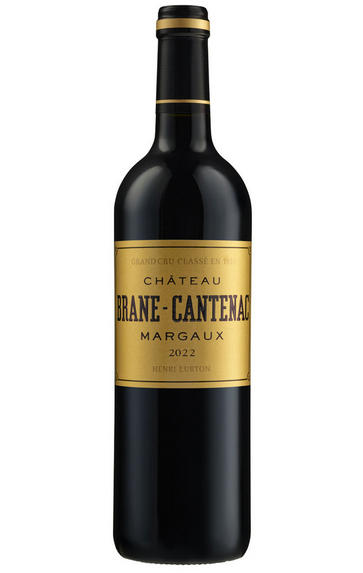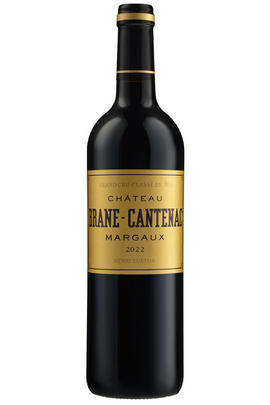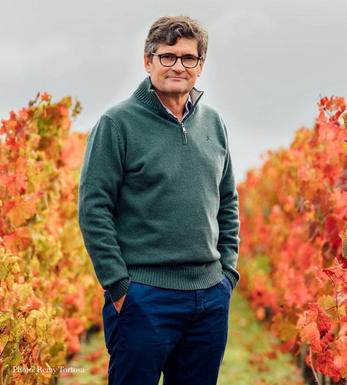
2022 Château Brane-Cantenac, Margaux, Bordeaux

Critics reviews
The 2022 Brane-Cantenac, as usual, is a wine that you must sit and contemplate before words gush forth. It was picked from 7 September to 10 October (their tiny plot of Carmenère) at 31.5hL/ha and contained 16% vin de presse from the Cabernet Sauvignon. It is well-defined and fresh, a very subtle Margaux, precise with blackberry, wild strawberry, cedar and tobacco scents.
As previous vintages have proven, a kind of “hidden depth” will become apparent post-bottling. The palate is medium-bodied with supple tannins, very elegant and unashamedly classic in style. This is blessed with haunting poise, composed and detailed on the finish.
This Margaux is not a show stopper, which in any case, is not really Henri Lurton/Brane Cantenac’s signature style. Instead, it is a wine that you will treasure 15 to 20 years down the road.
Drink 2030 - 2065
Neal Martin, Vinous.com (April 2023)
The 2022 Brane-Cantenac is captivating. Aromatic, savoury and layered, 2022 is so alluring from the outset. The natural radiance of the year is very much on display, and yet there is nothing that is overdone about the 2022.
Hints of blood orange, spice, rose petals, and minerals open over time, offering a stunning contrast to the sheer intensity of the fruit shaped by low yields and tiny berries. Brane-Cantenac is one of the most under-the-radar wines on the Left Bank. The 2022 is a stunner.
Drink 2030 - 2052
Antonio Galloni, Vinous.com (April 2023)
A blend of 74% Cabernet Sauvignon, 23% Merlot, 2% Cabernet Franc, and 1% Petit Verdot, the 2022 Brane-Cantenac has a pH of 3.61, and there is 15.8% press wine in the blend.
It has a deep garnet-purple colour, and it is a little subdued to start with notes of cedar chest and redcurrant preserves leading the charge, soon giving way to a profound core of crème de cassis, juicy black plums and candied violets, with a touch of iron ore.
The medium to full-bodied palate is simply electric, shimmering with bright, energetic black and red berry layers, supported by super-ripe, finely-grained tannins and excellent tension, finishing long and perfumed. Stunning!
Drink 2029 - 2059
Lisa Perrotti-Brown, The Wine Independent (May 2023)
Easily one of the best wines of the appellation. Red rose petal fragrance, damp earth, rosemary, baking spice, sandalwood, incense, graphite and slate. Exceptional balance, deep chocolate and mint character, lush damson and cassis fruits. Crushed violet flowers and salted cracker salinity are awe-inspiring.
Owner Henri Lurton has experience making wine overseas, in Baja California, which may have given insights into viticultural techniques n the heat, but the real key here is the old vine Cabernet Sauvignon planted in the 1950s and 1960s by his late father, Lucien Lurton. 100% new oak, from 8 coopers, and technical director Christophe Capdeville's meticulous approach to oak ageing care is also important.
42% of production in the 1st wine. All the young vines, even when co-planted in the same rows, were picked separately also this year.
Drink 2030 - 2050
Jane Anson, JaneAnson.com (April 2023)
74% Cabernet Sauvignon, 22% Merlot, 2% Cabernet Franc, 1% Carmenère, 1% Petit Verdot. Tasted at the château because Henri Lurton left the UGC tastings in 2022. The Airpulse system for mixing in air and managing the cap during red-wine fermentation (at low temperatures, around 26 °C) has been used here since 2019. Brane-Cantenac was the second to use it after Calon Ségur. Very soft extraction results. Cask sample.
Rich and round. Very gentle texture for a Cabernet-dominated wine, in which it is remarkably difficult to see the tannins. But apparently, the IPT (measure of total phenolics, including tannins) is up there. Henri Lurton agrees you can hardly see the tannins when you taste them. Sappy and appetising. Persistent.
Drink 2025 - 2042
Jancis Robinson MW, JancisRobinson.com (May 2023)
A blend of 74% Cabernet Sauvignon, 23% Merlot and the balance Cabernet Franc, Carmenère and Petit Verdot, the 2022 Brane-Cantenac unwinds in the glass with aromas of dark berries, crème de cassis, black truffles, loamy soil, burning embers and violets.
Medium to full-bodied, deep and velvety, with a fleshy core of fruit, terrific concentration and lively acids, it concludes with a long, perfumed finish. This is a terrific 2022 that may rival or surpass 2019 if it realizes all its potential in bottle.
William Kelley, Wine Advocate (April 2023)
A long and very linear red for Margaux with intense freshness and energy. The cabernet sauvignon shows real clarity with blackcurrants and flowers. Crushed stone. Firm and racy with lots of lemon rind and intensity. 74% cabernet sauvignon, 23% merlot, 1% cabernet franc, 1% petit verdot and 1% carmenere.
James Suckling, JamesSuckling.com (April 2023)
One of the year's standouts - a wonderful wine with so much to like. Coffee, tobacco, liquorice, dark chocolate, blackcurrants and floral scents on the nose. Smooth, succulent and velvety, this is amazing, juicy, bright, and vibrant. Pure and so effortless, tannins are filling but fine and delicate and have excellent clarity and fruit purity.
They really didn't try too hard but still delivered a powerful wine with concentration and intensity yet brightness and such generosity of fruit and acidity, which makes this so joyful. Simply wonderful.
Harvest 7 September-10 October. Yield of 31.5hl/ha. 3.61pH. 1% Petit Verdot and 1% Carmenere complete the blend. 42% production. 15.8% press wine. Ageing 18 months, 100% new oak. 3.57pH.
Drink 2029 - 2050
Georgina Hindle, Decanter.com (April 2023)
I was absolutely blown away by the 2022 Château Brane-Cantenac, which looks like a vintage reference point for this château. Based on 74% Cabernet Sauvignon, 23% Merlot, and the rest Cabernet Franc, Carmenère, and Petit Verdot, it sports a deep purple hue to go with incredible aromatics of crème de cassis, lead pencil, sandalwood, and spring flowers.
Medium to full-bodied on the palate, it shines for its purity of fruit, has ultra-fine tannins, a great mid-palate, and one heck of a finish. It hit 14.3% alcohol with a pH of 3.6, and like many estates today, they utilized quite a bit of press wine (15%) in the final blend. This is clearly up with the finest wines from the appellation and is well worth seeking out.
Jeb Dunnuck, JebDunnuck.com (May 2023)
About this WINE

Chateau Brane-Cantenac
Château Brane-Cantenac was for many years the home of Lucien Lurton - it is now owned and run by his son Henri. Its vineyards are located west of the village of Cantenac in the Margaux appellation. Brane-Cantenac's vineyards are planted with Cabernet Sauvignon (55%), Merlot (40%), Cabernet Franc (4.5%) and Carmenère 0,5%, and lie on fine, gravelly soils. Vinification includes up to 18 months' wood ageing, a third to a half in new `barriques'.
Brane Cantenac was perceived throughout much of the 70s and 80s as an underperforming property. Since Henri took over, there has been extensive investment in the cuverie and chai, as well as vastly improved vineyard management techniques. Consequently, the wines at Brane Cantenac now show more weight and concentration, although they still possess that haunting bouquet and quintessential elegance that characterise the wines of Margaux. It is classified as a 2ème Cru Classé.

Margaux
If Pauillac can be seen as the bastion of ‘traditional’ Red Bordeaux, then Margaux represents its other facet in producing wines that are among Bordeaux’s most sensual and alluring. It is the largest commune in the Médoc, encompassing the communes of Cantenac, Soussans, Arsac and Labaude, in addition to Margaux itself. Located in the centre of the Haut-Médoc, Margaux is the closest of the important communes to the city of Bordeaux.
The soils in Margaux are the lightest and most gravelly of the Médoc, with some also containing a high percentage of sand. Vineyards located in Cantenac and Margaux make up the core of the appelation with the best vineyard sites being located on well-drained slopes, whose lighter soils give Margaux its deft touch and silky perfumes. Further away from the water, there is a greater clay content and the wines are less dramatically perfumed.
Margaux is the most diffuse of all the Médoc appelations with a reputation for scaling the heights with irreproachable wines such as Ch. Margaux and Ch. Palmer, but also plumbing the depths, with too many other châteaux not fulfilling their potential. There has been an upward shift in recent years, but the appellation cannot yet boast the reliability of St Julien. However, the finest Margaux are exquisitely perfumed and models of refinement and subtlety which have few parallels in Bordeaux.
Recommended Châteaux: Ch. Margaux, Ch. Palmer, Ch. Brane-Cantenac, Ch. Rauzan-Ségla , Ch. Dufort-Vivens, Ch. Ferrière, Ch. du Tertre, Ch. Giscours, Ch. d'Angludet.

Cabernet Sauvignon Blend
Cabernet Sauvignon lends itself particularly well in blends with Merlot. This is actually the archetypal Bordeaux blend, though in different proportions in the sub-regions and sometimes topped up with Cabernet Franc, Malbec, and Petit Verdot.
In the Médoc and Graves the percentage of Cabernet Sauvignon in the blend can range from 95% (Mouton-Rothschild) to as low as 40%. It is particularly suited to the dry, warm, free- draining, gravel-rich soils and is responsible for the redolent cassis characteristics as well as the depth of colour, tannic structure and pronounced acidity of Médoc wines. However 100% Cabernet Sauvignon wines can be slightly hollow-tasting in the middle palate and Merlot with its generous, fleshy fruit flavours acts as a perfect foil by filling in this cavity.
In St-Emilion and Pomerol, the blends are Merlot dominated as Cabernet Sauvignon can struggle to ripen there - when it is included, it adds structure and body to the wine. Sassicaia is the most famous Bordeaux blend in Italy and has spawned many imitations, whereby the blend is now firmly established in the New World and particularly in California and Australia.


Buying options
Add to wishlist
Description
We felt this was one of the most delicious wines of 2022. It has a lovely limpid quality, with nothing overdone or unbalanced. There is purity and lift to it, with a precision and pinpoint focus on the fruit, with the tannins superbly integrated.
The wine is primarily from old vines planted by Henri Lurton’s father, Lucien, who died in 2023. The extraction is exceptionally soft and gentle. The wine is aged in 100% new oak. There is the highest ever proportion of press wine, but there is hardly a detectable trace in the wine – the sign of the great quality of the raw material, which has a seductive silkiness.
Cabernet Sauvignon 74%; Merlot 23%; Cabernet Franc 1%; Petit Verdot 1%; Carmenère 1%.
Drink 2029 - 2055
Score: 18/20
Berry Bros & Rudd (April 2023)
wine at a glance
Delivery and quality guarantee